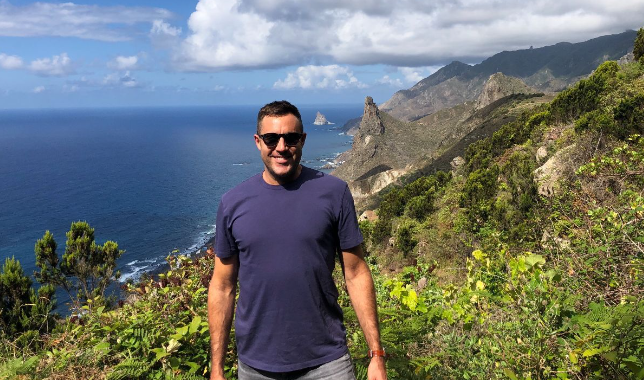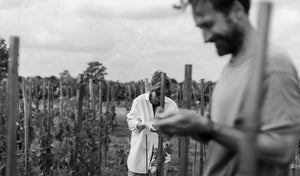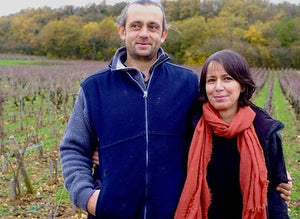Wine Yourself: Envínate Ribeira Sacra & Canary Island
April 26, 2024My enthusiasm for drinking Envínate is limitless. When asked what off-the-beaten-path wines I drink the most at home, my answer always begins with this gang of four. They continually go from strength to strength, from mainland Ribera Sacra and Almansa to the Canary Islands. My 2019 visit to both mainland Spain and the Canary Islands (pictured right) cemented my love of the wines and the people who craft them.
Translated to "wine yourself," Envínate was created by four friends studying enology at the University of Miguel Hernandez in 2005. Roberto Santana, Alfonso Torrente, Laura Ramos, and José Martínez slowly began consulting with wineries after college to discover forgotten sites with old vines planted on treacherous terrain. The previous generation saw the challenge as impossible, but this gang of four knew a treasured opportunity had presented itself.
Translated to "wine yourself," Envínate was created by four friends studying enology at the University of Miguel Hernandez in 2005. Roberto Santana, Alfonso Torrente, Laura Ramos, and José Martínez slowly began consulting with wineries after college to discover forgotten sites with old vines planted on treacherous terrain. The previous generation saw the challenge as impossible, but this gang of four knew a treasured opportunity had presented itself.
Below, you will find an incredible range of wines built upon freshness and balance. The raw source material here is farmed with the kind of attention you see paid in Burgundy's Grand Crus, and the stewardship from harvest to bottling is approached with the love and care that makes itself evident every time a bottle is opened.
Ribera Sacra (Mainland Spain)
Aldea is Envínate’s village wine, produced from a combination of 60-plus-year-old plots located in the ancient vineyard region of Ribeira Sacra. Mostly Mencía with other co-planted varietals blended in. The native vines are grown on steep slopes made of slate and sit between 400-600 meters in elevation.
Lousas Camiño Novo comes from a single vineyard of 80-100-year-old vines at 350- 450m, planted on dark gneiss and quartz, with richer iron-rich clay soils that are atypical for the area. This is the last site to be harvested, ripening slowly and more influenced by the Atlantic.
Lousas Seone is from two adjacent plots of 80-100-year-old vines that are planted on fine-grained gneiss and schist with a seam of quartz running down the middle. These plots are the first to be harvested yearly, ripening almost a month earlier than the Camiño Novo site.
Lousas Seone is from two adjacent plots of 80-100-year-old vines that are planted on fine-grained gneiss and schist with a seam of quartz running down the middle. These plots are the first to be harvested yearly, ripening almost a month earlier than the Camiño Novo site.
Lousas Rosende is from 28-60-year-old vines in the Rosende area on light, sandy, decomposed granite soils interspersed with feldspar crystals. Alfonso notes that the soils here recall St. Joseph and Cornas in the northern Rhône.
Tenerife (Canary Islands)
Palo Blanco comes Valle de la Orotava, one of Tenerife's first places planted to vines. Cooled by the trade winds and shaded by fog at higher altitudes, it hosts ancient vines trained in the historic Cordón Trenzado. These are 100+-year-old braided Listan Blanco vines planted in volcanic sand. Immediately pressed off their skins and aged in two Friulian 2500L oval foudres for ten months. There is no malolactic fermentation here, and the saline quality of this wine is extra pronounced.
La Santa de Úrsula hails from an area called La Carujera in the DO Tacoronte-Acentejo on the milder, more humid northeastern coast of Tenerife. It’s a blend of three parcels of 100-plus-year-old vines grown in sand, clay, and basalt soils between 350 and 650m above sea level.
Taganan comes from the area of the same name on Tenerife. Very old-fashioned: the vines grow untrained, the soil is worked by hand, and no chemicals are used.
Migan is sourced from two very old parcels of cordon trenzado (braided vines) Listan Negro. 60% comes from the La Habanera plot on volcanic sand at the area's highest elevation (600m), and 40% comes from the older San Antonio plot, lower on the slope and with more clay.
Benje Tinto is sourced from 1,000-meter-elevation, old-vine, pie franco parcels of Listan Prieto, with a bit of Tintilla, La Zanja, Valle de Arriba, and Llano Redondo, all located in Santiago del Teide.
Castile-La Mancha (Mainland Spain)
Albahra (Castilian for small sea) is named for the vineyard area in the Almansa region close to Albacete, located at the southeastern tip of Castilla-La Mancha. 70% Garnacha Tintorera (aka Alicante Bouchet) and 30% Moravia Agria. Black fruited, as Garnacha Tintorera is rare in that it has dark pulp.
.svg?v=162776257677185172071677832259)





